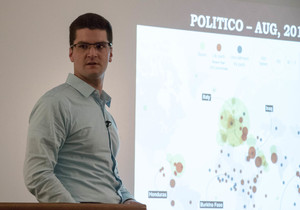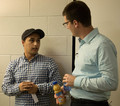McCarthy discusses the U.S. monetary-military complex

CHADRON The first Graves Lecture Series of the fall semester was presented by Chris McCarthy, a faculty member in the Business Academy. McCarthy’s program, “The Military-Monetary Complex,” is archived on the CSC YouTube Channel.
McCarthy, an economist, introduced his program with an infographic published by “Time” showing 1.3 million military personnel worldwide with 150,000 living in foreign countries. The number of U.S. military personnel in each country was represented by a corresponding circle.
“Why should we care? Is it a good thing for these countries to have U.S. bases? There’s a little bit of press around the fact that we have 1,200 troops in Belgium. But do we need that many there? Where’s the money going and what’s the impact on both those countries and ourselves?” he said.
He continued with a “Politico” infographic depicting the scope and breadth of U.S. military presence throughout the globe. The map included bases (over 200 employees), confirmed lily pads (fewer than 200 employees) and suspected lily pads.
A Heritage Institute study shows 23 percent of all U.S. servicepersons have been deployed in 54 countries, 24 of which are not currently involved in any military conflict.
In addition to deployed personnel, their housing allowances and salaries, the multiplier effect has an impact, both positive and negative on the countries hosting U.S. bases, according to McCarthy.
McCarthy quoted a report compiled by former deputy assistant secretary of defense, James Blaker, that estimates approximately 18 percent of total foreign military and economic aid is for bribing or buying access to establish military bases.
“A pretty significant chunk of the money we are supposed to be giving away charitably, we’re really just giving away so we can park assets and people in other countries,” McCarthy said.
The majority of international reserves in emerging countries is in U.S. currency. The scope of effects of this hoarding is not known, according to McCarthy.
“Two-thirds of the $100 bills the U.S. prints are abroad,” McCarthy said.
He also discussed exchange rates, imports and exports, and the billions paid to contractors.
Daler Abzhabarov, an MBA graduate student, approached McCarthy after the talk, to tell him the characterization of foreign citizens stuffing $100 bills in their mattresses is spot-on. Abzhabarov, an international student from Kyrgyzstan, told McCarthy his mother accumulates either gold or U.S. dollars, rather than the local currency due to the fluctuating purchasing power of the local currency and high inflation due to the government monetizing yearly deficits.
Abzhabarov said his mother and he experienced frequent bank runs within the Kyrgyzstan economy. As a result, Abzhabarov’s mother, like many others, decided to not deposit the gold or U.S. dollars in a bank or even a safety deposit box, for fear of confiscation.
After the conversation, Daler expressed his interest in McCarthy’s lecture topic and McCarthy invited him to help with the research.
The next Graves Lecture, by Dr. Sid Shuler, is Tuesday.
Category: Business, Campus News, Graves Lecture Series, Sandoz Society

